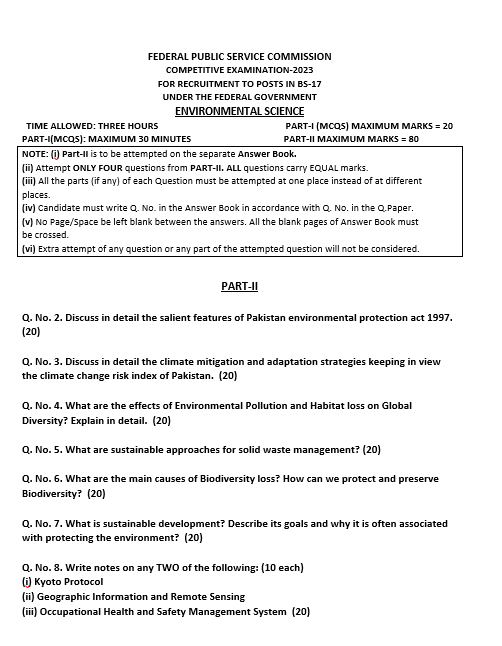Table of Contents
ToggleEnvironmental Sciences
Q. No. 2. Discuss in detail the salient features of the Pakistan environmental protection act 1997. (20)
Q. No. 3. Discuss in detail the climate mitigation and adaptation strategies keeping in view the climate change risk index of Pakistan. (20)
Q. No. 4. What are the effects of Environmental Pollution and Habitat loss on Global Diversity? Explain in detail. (20)
Q. No. 5. What are sustainable approaches for solid waste management? (20)
Q. No. 6. What are the main causes of Biodiversity loss? How can we protect and preserve Biodiversity? (20)
Q. No. 7. What is sustainable development? Describe its goals and why it is often associated with protecting the environment. (20)
No. 8. Write notes on any TWO of the following: (10 each)
- Kyoto Protocol
- Geographic Information and Remote Sensing
- Occupational Health and Safety Management System
Read Related Article
CSS Environmental Science Paper 2016
CSS Environmental Science Paper 2017
CSS Environmental Science Paper 2018
CSS Environmental Science Paper 2019
CSS Environmental Science Paper 2020
CSS Environmental Science Paper 2021
CSS Environmental Science Paper 2022
Environmental Sciences Past Paper 2024
Summaries of Questions
No. 2. Discuss in detail the salient features of the Pakistan Environmental Protection Act 1997. (20)
The Pakistan Environmental Protection Act (PEPA) of 1997 establishes a legal framework for environmental protection in Pakistan. Key features include the creation of the Pakistan Environmental Protection Agency (PEPA), mandatory environmental impact assessments (EIA) for development projects, the regulation of hazardous substances, and setting standards for air and water quality. The Act also empowers the government to enforce environmental laws and penalties for non-compliance. It emphasizes the prevention of environmental damage and promotes sustainable development.
No. 3. Discuss in detail the climate mitigation and adaptation strategies keeping in view the climate change risk index of Pakistan. (20)
Climate mitigation strategies focus on reducing greenhouse gas emissions through renewable energy adoption, energy efficiency, forest conservation, and reducing carbon footprints in industries. Adaptation strategies include developing climate-resilient infrastructure, improving water management practices, adopting drought-resistant crops, and enhancing disaster preparedness. Given Pakistan’s vulnerability as reflected in the climate change risk index, these strategies aim to minimize the impacts of extreme weather events like floods and droughts while ensuring long-term environmental sustainability.
No. 4. What are the effects of Environmental Pollution and Habitat Loss on Global Diversity? Explain in detail. (20)
Environmental pollution and habitat loss have severe effects on global biodiversity. Pollution, such as air and water contamination, can poison ecosystems, harm species, and disrupt food chains. Habitat loss, primarily due to deforestation and urbanization, reduces the area available for wildlife, leading to population declines and species extinction. Both factors contribute to the erosion of biodiversity, affecting ecosystem services such as pollination, water purification, and climate regulation, ultimately destabilizing global ecosystems.
No. 5. What are sustainable approaches for solid waste management? (20)
Sustainable solid waste management involves strategies that minimize waste generation, enhance recycling, and reduce environmental impacts. Key approaches include: 1) Source reduction to minimize waste, 2) Recycling and composting to recover resources, 3) Waste-to-energy technologies to generate power from waste, 4) Proper disposal through sanitary landfills with methane capture, and 5) Promoting public awareness and behavioral change to encourage waste reduction and responsible disposal.
No. 6. What are the main causes of Biodiversity loss? How can we protect and preserve Biodiversity? (20)
The main causes of biodiversity loss include habitat destruction, climate change, pollution, over-exploitation of resources, and invasive species. To protect and preserve biodiversity, efforts should focus on creating protected areas, restoring degraded ecosystems, reducing pollution, promoting sustainable agriculture and fisheries, and raising awareness about the importance of biodiversity. Legal protections and international agreements also play a vital role in conservation.
No. 7. What is sustainable development? Describe its goals and why it is often associated with protecting the environment. (20)
Sustainable development is a development that meets the needs of the present without compromising the ability of future generations to meet their own needs. Its goals include promoting economic growth, social inclusion, and environmental protection. Sustainable development is associated with protecting the environment because it focuses on using natural resources efficiently, reducing pollution, and ensuring long-term ecological balance, which is essential for the well-being of both current and future populations.
No. 8. Write notes on any TWO of the following:
- Kyoto Protocol: The Kyoto Protocol, adopted in 1997, is an international treaty under the UNFCCC that commits industrialized nations to reduce their greenhouse gas emissions. It introduced legally binding targets for these countries, aiming to combat climate change by reducing emissions of carbon dioxide, methane, and other greenhouse gases.
- Geographic Information and Remote Sensing: Geographic Information Systems (GIS) and Remote Sensing (RS) are technologies used to collect, analyze, and interpret spatial data. GIS integrates geographic data with various other information sources, while remote sensing uses satellites or aerial sensors to gather data about the Earth’s surface. These tools are essential for environmental monitoring, urban planning, disaster management, and resource management.
